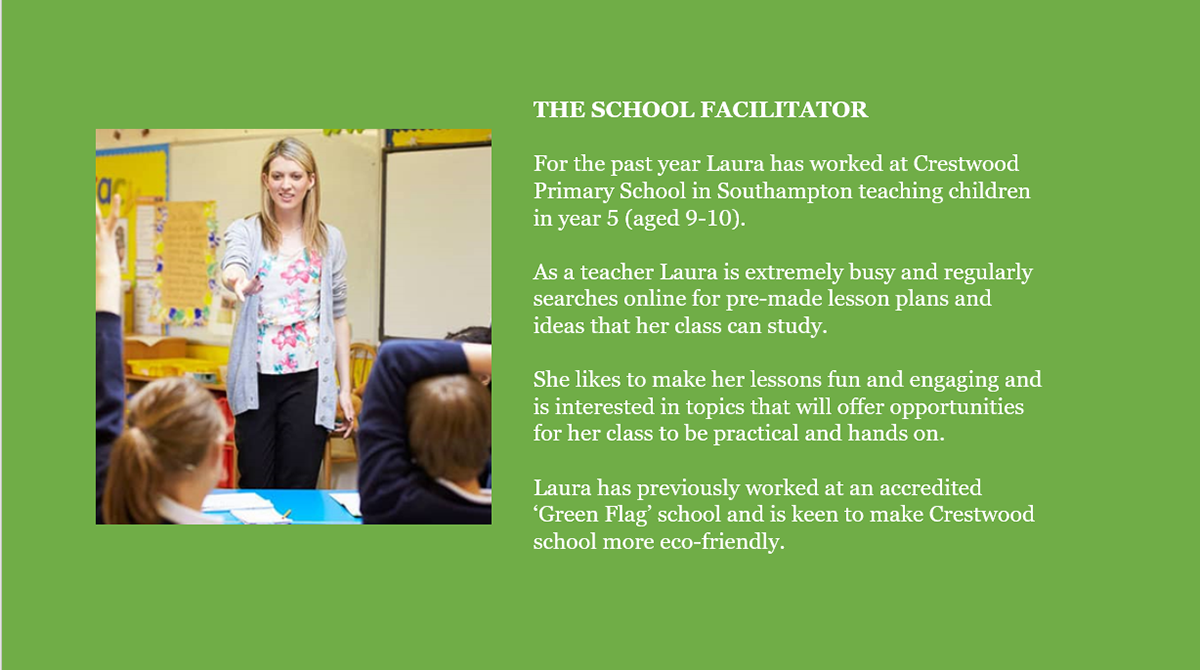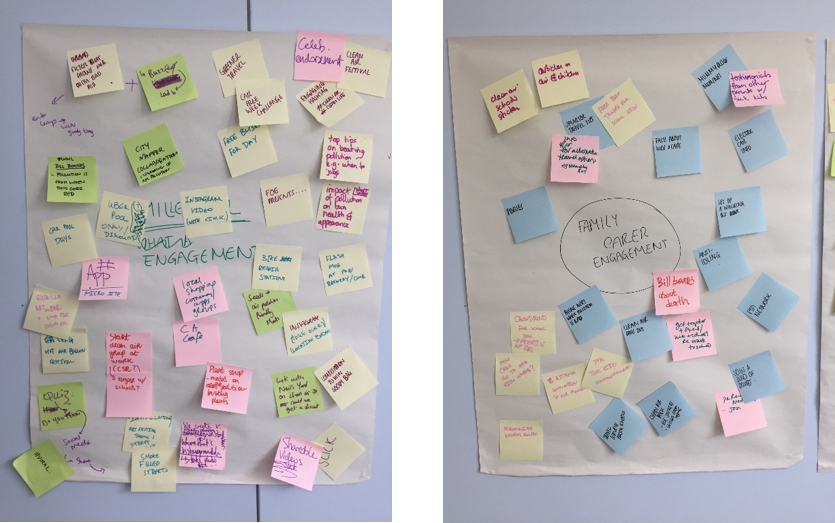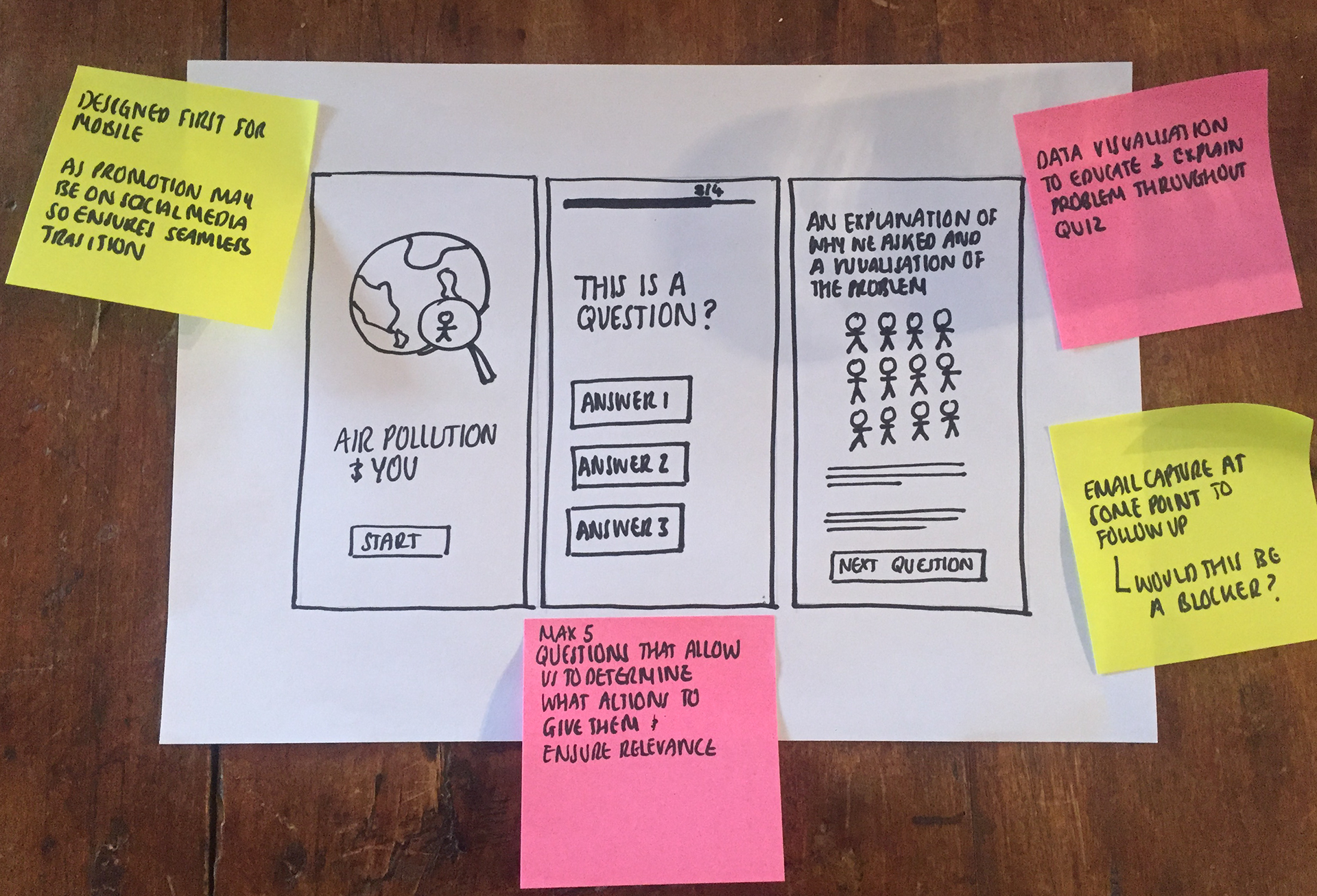In the summer of 2018 A UX strategy was produced to recommend best practice for creating quality digital experiences that can serve as a building block to encourage offline, impactful action in line with Friend’s of the Earth’s mission and values.
The strategy is fuelled by data and insights which impact everything from integration into preferred audience experiences to human-centric design.
The strategy is underpinned by several models that work with existing consumer mindsets towards charity as well as pushing the audience into new ways of acting through technology.
THE ROLE
UX Strategist
UX Strategist
As the UX Strategist I used user insights gathered from research, psychology, and UX best practices to takes a consumer-centric approach to making strategic decisions, acting as a change agent within Friends of the Earth.
I presented works and led workshops to gain buy‐in from executives, senior stakeholders and many other teams throughout the project lifecycle.
Delivering UX workshops early in the process allowed ideas and rationale to be communicated to product teams and stakeholders.
THE CHALLENGE
Why a UX Strategy?
Why a UX Strategy?
Supporter behaviour is changing fast:
Digital has had a transformative effect on users thinking and behaviour. Potential supporters are no longer willing to wait for experiences to be created for them: they are putting them together themselves. This this makes the decisions they make, like whether to buy a brand’s product, or whether to support a certain charity, increasingly difficult to understand or predict.
Digital has had a transformative effect on users thinking and behaviour. Potential supporters are no longer willing to wait for experiences to be created for them: they are putting them together themselves. This this makes the decisions they make, like whether to buy a brand’s product, or whether to support a certain charity, increasingly difficult to understand or predict.
More touchpoints. Lots and lots more touchpoints:
Each new tool and technology tends to be bolted onto organisation existing business model; given a home within existing organisational silos. These silos increasingly struggle to collaborate in the creation of a high value customer experience.
Each new tool and technology tends to be bolted onto organisation existing business model; given a home within existing organisational silos. These silos increasingly struggle to collaborate in the creation of a high value customer experience.
Engaging new and existing audiences:
Without a shared understanding of our users, or a shared vision for how they need to be served, we are unable to create a coherent and valuable customer experience. Engaging people today is more of a challenge than ever.
Online engagement should drive real offline action:
To drive change and deliver lasting results Friends of the Earth need to influence policymakers, grow the strength of their campaigns and promote changes to individuals’ lives.
THE APPROACH
Iterative. Lean. Human-centric
Iterative. Lean. Human-centric
The UX approach taken in this project involved deeply understanding the users through research, organising information, visual design (and more), all with the goal of meeting user needs and doing it elegantly.
Friends of the Earth’s mission is to provide a healthier environment for current and future generations. While producing excellent user experience is certainly an objective for the organisation, it is not the end goal. Producing a strategy that is mindful of the organisational context and aligns strongly with the mission was the first step in ensuring an effective strategy.
The strategy needed to engage all employees and stakeholders across the organisation so that it can be executed and contribute to long-term outcomes. The UX workshop tested the organisational conviction to UX approaches and paved the way for a methodology that is rooted in audience centric design.
In the validation and finalisation stages, two projects were progressed using the principles and methodology outlined in the UX strategy. The aim of both projects was to drive offline action and therefore validate the recommendations of the UX strategy.
The project approach taken ensured a user-centric focus from kick off to development. Cross-department collaboration meant that everyone was agreed on the project vision and holistic user journeys were produced that captured the entire desired experience.
THE CREATION
Discovery
Discovery
The literature review, digital trends and case studies surveyed books, scholarly articles, and other relevant sources to understand how a UX strategy would fit into a broader context.
The strategy needs to reflect all the key stakeholders of an organisation. To consider these voices interviews were conducted with various FOE employees from a wide range of departments.
To understand how users are currently interacting with FOE’s main online offering, the website, a variety of reports were generated and analysis. In addition, a social media review analysed the charity’s social accounts to see how each channel was performing, what was resonating with audiences and where there was potential to improve.
Evolution and engagement
Users at a plastic free event were invited to complete a supporter questionnaire asking for anonymous information about their online behaviour and opinions regarding Friends of the Earth’s campaigns and issues. User journeys were subsequently created from these to help Friends of the Earth understand how supporters are originally engaging with them and how this can be translated into a longer-term relationship.
During this stage stakeholders gathered to take part in a UX workshop lead by myself to evaluate potential UX approaches and validate the findings found in the discovery stage.
Application strategy
During the UX strategy development a range of areas were identified that can be applied to improve user experience across the organisation. The opportunities represent both social activism opportunities, whereby the output could lead to enhanced supporter experiences that are most conductive to the overall organisational mission, and also wider organisational changes that can help Friends of the Earth increase their UX maturity model by ensuring goals are clearly embedded with the organisation's mindset and stakeholders have a clear understanding of their roles in the process.
The Social Activism and Digital Delivery teams then evaluated the proposed activities according to their value and feasibility to help inform their digital roadmap.
Validation and finalisation
Two smaller projects were then progress as a way of testing and validating the UX strategy principles and methodology.
Firstly, usability studies were conducted to highlight areas of the website which could be improved, and design recommendations were prototyped and tested to ensure a better user experience.
The final proposed design covered the user interface of the system in terms of visuals and aesthetics and the user experience aspects in terms of interactions, user flow and behaviour.
A second project investigated and developed a new engagement tool for Friends of the Earth. It focused on using data-driven insights and analytics to design and develop a product for specific target audiences as part of a wider journey to change their offline behaviour towards a particular issue.

Using user data gathered, personas were developed that represented five different subsets of the audience most likely to engage with the clean air campaign. Each persona has different goals, behaviours, motivations and needs that in relation to the clean air campaign

From the user personas journey maps were created for each user personas. These are a visualisation of the end-to-end experience of how they are most likely to interact with the clean air campaign and were used to identify opportunities to align what the users what to accomplish with the goals of the campaign.

Colleagues from across the FOE organisation took part in a workshop where specific ideation techniques and exercises were utilised to uncover new methods, approaches, practices, and ways of improving the complete user experience related to the clean air campaign.

Paper prototyping was adopted for the first iteration of the proposed redesign. This allowed for a fast and inexpensive way to demonstrate early design ideas and allowed for rapid evaluation and testing.
THE DELIVERABLE
A UX Strategy as an enabler
A UX Strategy as an enabler
The final UX strategy acts as an enabler to connect individuals, communities and societies to the Friends of the Earth campaigns. This is done through improving the overall experience of the users when they interact with the charity and allows the Friends of the earth to define supporter experiences that are most conductive to the organisational mission.
Aligning the UX strategy to organisational objectives allowed us to identify how user experience can help make Friends of the Earth more effective as an organisation.
THE IMPACT
The project approach taken ensured a user-centric focus from kick off to development. Cross-department collaboration meant that everyone was agreed on the project vision and holistic user journeys were produced that captured the entire desired experience. The UX strategy provided an iterative process of ideation, prototyping and testing and a solution could therefore be developed and adapted to meet user needs.
“Gemma partnered with key stakeholders
across FOE to understand clearly our organisational needs, supporter insights and the current landscape. The resulting strategy demonstrates Gemma’s passion and excellence for UX, and will continue the evolution and innovation of our digital capabilities”
across FOE to understand clearly our organisational needs, supporter insights and the current landscape. The resulting strategy demonstrates Gemma’s passion and excellence for UX, and will continue the evolution and innovation of our digital capabilities”
Jo Farncombe, Digital Delivery Manager, Friends of the Earth
Testing with real-life projects helped to validate the elements of the UX strategy. Successful outputs should be communicated across the organisation to help socialise the strategy with colleagues across the organisation to secure buy-in.
Friends of the Earth are now working to capitalise on the momentum built throughout this project and are continuing to refine the opportunities available to them, identify capacity and owners, and start progressing items. They are currently using the UX strategy to identify a target audience and vision to guide their future campaign development.
If you're doing exciting things and need help with anything user experience related, I'd love to talk.

